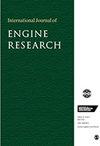应用强化燃烧策略和优化点火正时,实现船用合成氨发动机满负荷状态下的高热效率和低 N2O 排放
IF 2.1
4区 工程技术
Q2 ENGINEERING, MECHANICAL
引用次数: 0
摘要
为满足减少温室气体(GHG)排放的要求,无碳燃料氨在船用发动机中的应用变得越来越重要。然而,使用氨作为燃料会导致发动机热效率低、污染物排放量高。提高发动机中燃料混合物的燃烧速率有助于解决这一问题。因此,通过数值模拟,研究了主腔中氢气体积分数(XH2)和氧气体积分数(XO2)对带有前腔的船用氨发动机的燃烧和排放特性的影响。通过调整点火起始点(SOI)进行了进一步分析,以优化发动机性能和排放。结果表明,增加 XH2 和 XO2 都有助于提高指示热效率 (ITE) 和减少 N2O 排放。然而,这通常伴随着更高的氮氧化物排放,尤其是在高 XO2 的情况下。此外,调整 SOI 使发动机的 ITE 在每种情况下都大于 47.6%,并减少了约 80% 的温室气体排放(40 ppm N2O)。最后,化学动力学分析表明,富氧或富氢条件并没有改变主要的反应途径。本文章由计算机程序翻译,如有差异,请以英文原文为准。
Application of enhanced combustion strategies and optimized ignition timing for achieving high thermal efficiency and low N2O emissions of marine ammonia engine at full-load condition
To meet the requirement of reducing greenhouse gas (GHG) emissions, the application of carbon-free fuel ammonia in marine engines has gained importance. However, the use of ammonia as fuel leads to low thermal efficiency and high emissions of pollutants in engines. Increasing the rate of combustion of the fuel mixture in the engine helps to solve this problem. Therefore, the influence of hydrogen volume fraction (XH2 ) and oxygen volume fraction (XO2 ) in the main chamber, via numerical simulations, on the combustion and emission characteristics of a marine ammonia engine featuring a pre-chamber. Further analysis was conducted via adjustments in the start of ignition (SOI) to optimize both engine performance and emissions. The results showed that the increase of both XH2 and XO2 contributed to the improvement of indicated thermal efficiency (ITE) and the reduction of N2 O emissions. However, this is usually accompanied by higher NOx emissions, especially in the case of high XO2 . In addition, adjusting the SOI resulted in the engine ITE is greater than 47.6% in each case and reduces GHG emissions by about 80% (<40 ppm N2 O). Finally, chemical kinetic analysis showed that oxygen-enriched or hydrogen-enriched conditions did not change the main reaction pathway.
求助全文
通过发布文献求助,成功后即可免费获取论文全文。
去求助
来源期刊

International Journal of Engine Research
工程技术-工程:机械
CiteScore
6.50
自引率
16.00%
发文量
130
审稿时长
>12 weeks
期刊介绍:
The International Journal of Engine Research publishes high quality papers on experimental and analytical studies of engine technology.
 求助内容:
求助内容: 应助结果提醒方式:
应助结果提醒方式:


